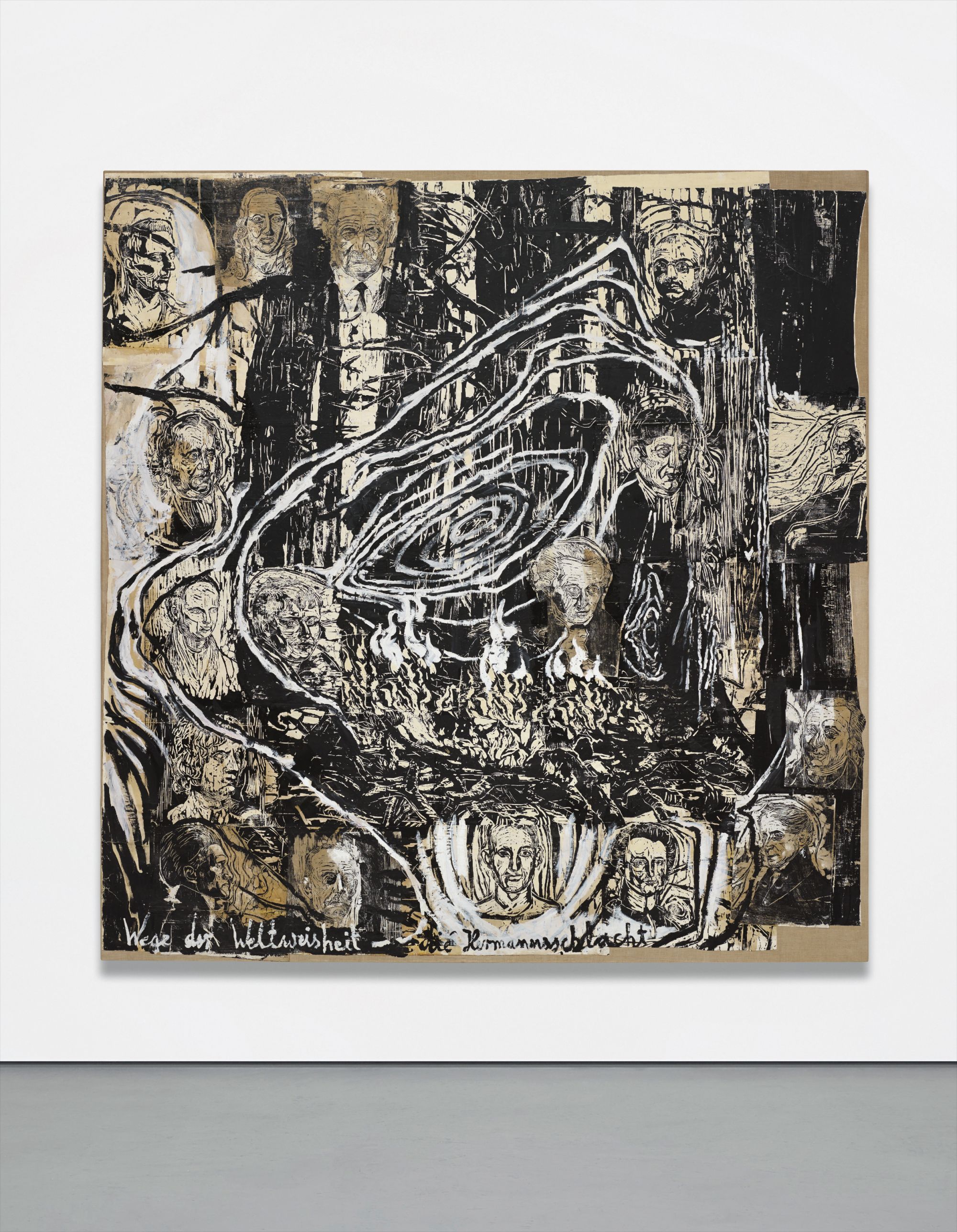

Property from a Private Collection, Chicago
40
Anselm Kiefer
Wege Der Weltweisheit - Die Herrmannsslacht
woodcut, oil and shellac on paper, laid down on canvas
342.9 x 330.2 cm (135 x 130 in.)
Titled 'Wege der Wesltweisheit - die Hermannsschlacht' along the lower edge. This work is unique.
Full-Cataloguing
Anselm Kiefer’s artistic oeuvre is characterised by an intensive analysis of post-war Germany’s national identity and collective memory. Through his work, Kiefer investigates how the German Nationalist Party created false myths that reinforced and proclaimed the greatness of the Third Reich. His practice is prominently rooted in remembering the past, through an immersive exploration of national power, symbols and myths. Through this, Kiefer’s art should be seen as the high road to redemption.
Wege Der Weltweisheit - Die Herrmannsslacht, 1978, is an exceptional example of Kiefer’s interest in history; it presents a genealogy of historical German figures, whose portraits are set within a forest and connected by rings of tree trunks. This work belongs to a larger series of woodcut collages that the artist conceived in the late 1970s and early 1980s. The title alludes to the Battle of Hermann (also known as Hermannschlacht) – a leader of the Germanic tribes, who successfully defeated the Romans in the Battle of Teutoburg Forest in 9 AD, thereby ensuring German independence from the Roman Empire. Hermann represented a symbol of power for the nineteenth-century German nationalists and his figure was used to affirm the superiority of the Aryan race. The characters portrayed in the present lot are intellectuals, poets, Prussian and Nazi leaders from the eighteenth and nineteenth centuries. They are inserted in the composition without any clear structure. However, the argument advanced by Kiefer in this painting is that we should not condemn these historical figures; on the contrary we must rescue them from their identification with Nazi Germany.
What makes this lot outstanding is not only its subject, but also its material composition. Kiefer uses the canvas as a battleground for his exploration of history and memory. His practice reiterates the same process of his teacher Joseph Beuys, an artist famous for his conceptual installations and performances that aimed at reconciling Germany’s haunting past and personal trauma perpetrated by the Second World War. The working with woodcuts oil and shellac on paper, later laying these elements onto canvas, are a way to accommodate the subject: Kiefer prints these figures through a thick impasto of paint, placing them in a barren and sinister landscape that echoes a battlefield. Despite the darkness of the landscape, Kiefer finds hope in this desolation: ‘History has shown us that there is always darkness inside the light…Maybe we should be looking more carefully into the darkness’ (M. Auping, Anselm Kiefer: Heaven and Earth, Prestel Publishing, 2005, p. 35).
Wege Der Weltweisheit - Die Herrmannsslacht, 1978, is an exceptional example of Kiefer’s interest in history; it presents a genealogy of historical German figures, whose portraits are set within a forest and connected by rings of tree trunks. This work belongs to a larger series of woodcut collages that the artist conceived in the late 1970s and early 1980s. The title alludes to the Battle of Hermann (also known as Hermannschlacht) – a leader of the Germanic tribes, who successfully defeated the Romans in the Battle of Teutoburg Forest in 9 AD, thereby ensuring German independence from the Roman Empire. Hermann represented a symbol of power for the nineteenth-century German nationalists and his figure was used to affirm the superiority of the Aryan race. The characters portrayed in the present lot are intellectuals, poets, Prussian and Nazi leaders from the eighteenth and nineteenth centuries. They are inserted in the composition without any clear structure. However, the argument advanced by Kiefer in this painting is that we should not condemn these historical figures; on the contrary we must rescue them from their identification with Nazi Germany.
What makes this lot outstanding is not only its subject, but also its material composition. Kiefer uses the canvas as a battleground for his exploration of history and memory. His practice reiterates the same process of his teacher Joseph Beuys, an artist famous for his conceptual installations and performances that aimed at reconciling Germany’s haunting past and personal trauma perpetrated by the Second World War. The working with woodcuts oil and shellac on paper, later laying these elements onto canvas, are a way to accommodate the subject: Kiefer prints these figures through a thick impasto of paint, placing them in a barren and sinister landscape that echoes a battlefield. Despite the darkness of the landscape, Kiefer finds hope in this desolation: ‘History has shown us that there is always darkness inside the light…Maybe we should be looking more carefully into the darkness’ (M. Auping, Anselm Kiefer: Heaven and Earth, Prestel Publishing, 2005, p. 35).